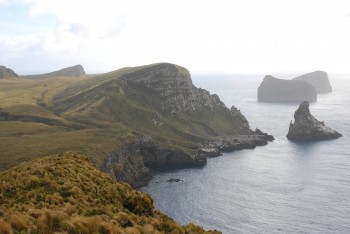Planning for the eradication of introduced House Mice Mus musculus on New Zealand’s Antipodes Island is now underway with the Department of Conservation (DOC) recently appointing a Project Manager to run the exercise (click here). It is aimed to make the eradication attempt during the southern (austral) winter of 2015.

Antipodes Island with offshore (and mouse-free) stacks and islets
Photograph by Erica Sommer
The project has been “kick-started” by the Million Dollar Mouse campaign which so far has raised NZ$ 931 818 towards its target. Field work necessary prior to an eradication attempt was conducted on Antipodes in July this year by a joint expedition from DOC and the University of Auckland (click here).
“The main goal of the trip was monitoring a 6 hectare area which the team treated with non-toxic bait containing the biomarker pyranine, simulating what would happen in a real eradication. The biomarker glows under UV light allowing scientists to track bait consumption by animals. The University of Auckland team focused on exhaustively trapping mice throughout the monitored area to estimate mouse density and confirm 100% bait consumption which is required for eradication to be successful. The Department of Conservation team focused on capturing all birds, particularly the endemic parakeet species, to estimate the rate of bait consumption by these non-target species, which should be as close to 0% as possible.”
“One hundred mice were captured and the rate of bait consumption was 100%. The 2013 winter was the mildest on record for New Zealand and accordingly the density of mice was as high as it has been recorded in summer (previous work from 2011), over 80 per hectare, emphasising the urgency in eradicating mice from this island where they are constantly at plague densities, especially with a warming climate. Thirty-five parakeets were captured and showed no signs of consuming bait, and were held in temporary captivity for observation. The team also continued invertebrate monitoring at five sites to set a baseline for ecosystem recovery after mouse eradication.”
Although there is yet no evidence that the mice are preying upon seabirds, including ACAP-listed albatrosses and petrels, on Antipodes Island (in contrast to the situation at Gough and Marion Islands), they have apparently had a marked effect on the island’s invertebrates.

Antipodean Albatrosses on Antipodes Island: not yet affected by mice?
Photograph by Erica Sommer
The results of the 2015 eradication exercise on Antipodes Island should inform long-standing plans to eradicate House Mice on Gough Island in the South Atlantic (click here for the latest news on that project). It is now well known that Gough’s “killer mice” are wreaking havoc among the island’s ACAP-listed species (most especially the Critically Endangered Tristan Albatross Diomedea dabbenena) and its suite of burrowing petrels alike (click here).
With thanks to Erica Sommer for photographs.
Selected References:
Russell, J.[C.] 2012. The Million Dollar Mouse. Newsletter of the Australasian Wildlife Management Society 26(2): 6-7.
Russell, J.C. 2012. Spatio-temporal patterns of introduced mice and invertebrates on Antipodes Island. Polar Biology 35: 118701195.
John Cooper, ACAP Information Officer 15 December 2013

 English
English  Français
Français  Español
Español